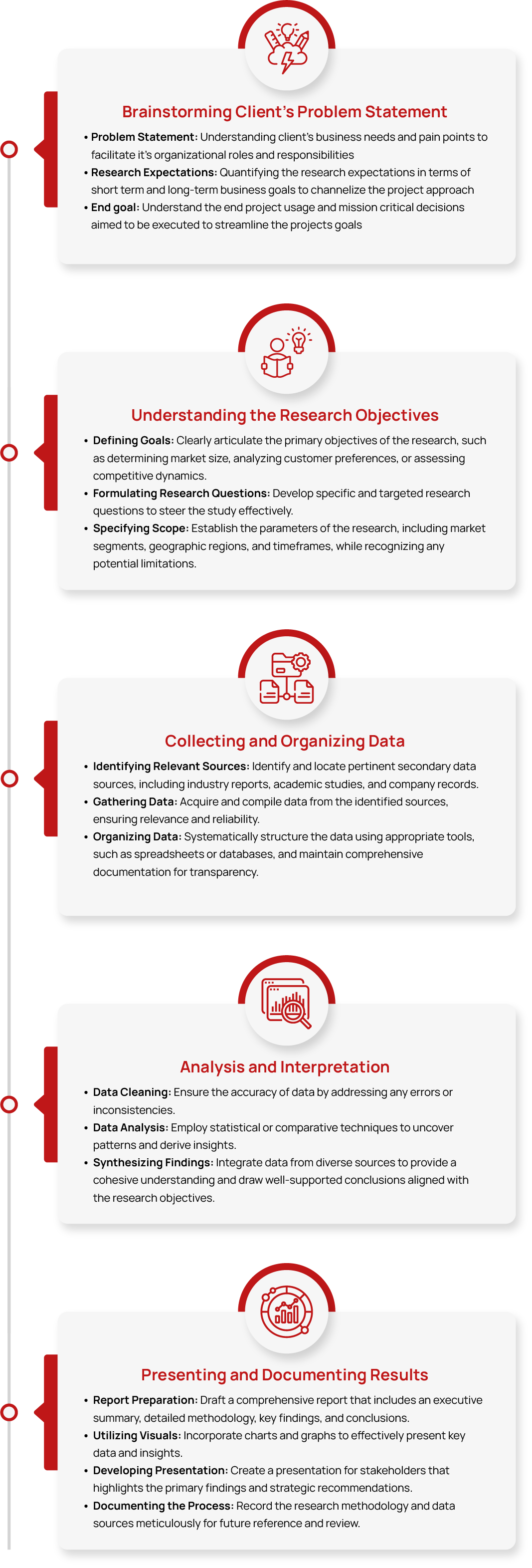Global Business Intelligence Market Size, Share, Growth and Trend Analysis Report, 2032
- Summary
- Market Landscape
- Methodology
- Table of Content
Global Business Intelligence Market Size, Share & Growth and Trend Analysis Report, By Deployment (Cloud, On-premises), By Enterprise Type (Small and Medium-Sized Enterprises (SMEs), Large Enterprises), By End-use Industry (BFSI, IT and Telecommunication, Retail and Consumer Goods, Manufacturing, Healthcare, others) and Regional Forecasts (Asia Pacific, Europe, North America, Latin America and Middle East & Africa), 2024 – 2032
The Business Intelligence (BI) Market refers to the technologies, tools, and strategies used by organizations to analyze and interpret vast amounts of data to make informed business decisions. BI solutions enable businesses to collect, process, and present actionable insights from historical, current, and predictive data, aiding in strategic planning, performance monitoring, and operational optimization. These solutions include data visualization, reporting, analytics, and dashboards, helping companies drive efficiency, identify trends, and improve decision-making processes. As data-driven decision-making becomes increasingly crucial, the BI market continues to grow across industries such as healthcare, finance, retail, and manufacturing.
The Global BI Market was valued at approximately USD XX billion in 2024 and is projected to grow at a compound annual growth rate (CAGR) of around 13% from 2025 to 2032. By the end of the forecast period, the market size is expected to surpass USD XX billion.
Industry Trends
The business intelligence (BI) market is driven by the growing need for data-driven decision-making across industries. Organizations are increasingly leveraging BI tools to analyse vast amounts of data, uncover actionable insights, and improve operational efficiency.
The integration of AI and machine learning with BI platforms allows for advanced analytics, predictive modelling, and automated insights, further enhancing decision-making capabilities. The widespread adoption of cloud-based BI solutions has made data access more flexible, scalable, and cost-effective.
Furthermore, the demand for real-time data processing and analytics is pushing businesses to adopt BI solutions for faster and more accurate decision-making. The rise of self-service BI tools also enables non-technical users to extract insights, democratizing data across the organization.
However, the BI market faces several challenges that may hinder its growth. Data privacy and security concerns remain a critical issue, particularly with the increasing volume of sensitive information being processed.
Integrating multiple data sources and ensuring data consistency across disparate systems can also be complex and time-consuming. Many organizations still struggle with data quality, which can lead to inaccurate insights and suboptimal decision-making.
Additionally, the high costs associated with implementing and maintaining BI tools, especially for small to medium-sized enterprises, could limit their adoption. Despite the advancements in BI technology, some businesses face resistance to change and lack the necessary skills to effectively utilize BI tools.
These challenges must be addressed for the continued growth of the BI market.
Industry Expert’s Opinion:
- Brian Balfour, Founder and CEO of Reforge, Former VP of Growth at Hubspot
“As you gain fresh insight from your data, it opens the door to new questions. As you have new questions, you need to update your instrumentation and analysis. Saying the process is “done” is saying you understand everything there is to know about your users, product, and channels.”
- Matin Movassate, Founder and CEO at Heap Analytics
“Analytics software is uniquely leveraged. Most software can optimize existing processes, but analytics (done right) should generate insights that bring to life whole new initiatives. It should change what you do, not just how you do it.”
TT Consultants’ Perspective
The future of the business intelligence (BI) market is poised for significant growth, driven by advancements in artificial intelligence (AI), machine learning (ML), and automation. As organizations increasingly focus on real-time data analytics, BI solutions will evolve to offer more interactive, intuitive, and AI-powered features.
The integration of cloud-based BI platforms will further enhance accessibility, scalability, and collaboration across departments and geographies. Additionally, the rise of big data and the need for data-driven decision-making will continue to fuel the demand for BI tools.
The increasing adoption of predictive analytics and self-service BI solutions will empower non-technical users, democratizing data access. The focus will also shift towards personalized insights and data security to meet compliance standards. As a result, the BI market is expected to see continued innovation and widespread adoption across various sectors.
Market Segmentation
1. By Deployment (Cloud, On-premises)
The Business Intelligence (BI) market is increasingly shifting towards cloud-based deployment, driven by the growing demand for flexibility, scalability, and cost-efficiency. Cloud-based BI solutions enable organizations to access real-time data insights, collaborate more effectively, and reduce the need for heavy upfront investments in infrastructure.
Cloud deployment allows for seamless integration with other cloud services, providing enhanced analytical capabilities and access to a wide range of BI tools and features. It is particularly popular among small to medium-sized enterprises (SMEs) that require affordable and scalable BI solutions.
On the other hand, on-premises deployment continues to be favoured by large enterprises and sectors with strict data security requirements, such as government, finance, and healthcare. On-premises BI solutions offer greater control over data and infrastructure, enabling organizations to maintain compliance with local regulations and policies.
While on-premises deployments are typically more expensive due to infrastructure and maintenance costs, they remain essential for companies that need to keep sensitive data within their organizational premises. Despite the growing cloud adoption, on-premises solutions are expected to remain relevant in industries where data privacy and control are paramount.
2. By Enterprise Type (Small and Medium-Sized Enterprises (SMEs), Large Enterprises)
Small and medium-sized enterprises (SMEs) are increasingly adopting BI tools to enhance operational efficiency and drive growth. The SME segment is expected to grow at a CAGR of XX% during the forecast period, fueled by the availability of affordable and user-friendly BI solutions.
Large enterprises, on the other hand, continue to invest heavily in advanced BI systems to manage and analyse vast volumes of data, optimize business processes, and improve decision-making, with a projected CAGR of XX%.
3. Industry Vertical (IT & Telecom, BFSI, Media & Entertainment, E-commerce & Retail, Healthcare & Pharmaceuticals and Other)
The IT and telecommunication sector secured the largest revenue share of about USD XX Bn for 2024 in the global business intelligence (BI) market. Business intelligence enables telecom companies to optimize pricing strategies, tailor marketing campaigns, and develop products based on in-depth consumer insights and informed decision-making.
In this sector, BI enhances network performance, operational efficiency, and customer satisfaction, driving increased demand for its applications in IT and telecommunications. On the other hand, the BFSI sector is expected to exhibit the fastest market growth of XX% during the forecast period.
BI tools in BFSI enhance profitability by enabling real-time reporting, improving customer retention, managing risks, streamlining workflows, and simplifying data management.
4. By Region (North America, Europe, Asia Pacific, Latin America, Middle East Africa)
North America is expected to hold the largest market share of USD XX bn in 2024 and Asia Pacific is poised for the highest growth rate with a CAGR of XX%. North America holds a dominant share in the market, primarily driven by the strong presence of large enterprises, advanced technology infrastructure, and high adoption of cloud-based solutions.
The U.S. is a key contributor, with organizations across various sectors leveraging BI tools for better data-driven decision-making. Europe, while also a mature market, is experiencing steady growth due to the increasing demand for data analytics and the integration of AI-driven BI solutions.
The region is also witnessing a surge in BI adoption across industries like healthcare, manufacturing, and retail, with strong regulatory support.
Asia Pacific is emerging as a fast-growing region, driven by the rapid digital transformation, growing adoption of BI tools, and the rise of small and medium enterprises (SMEs) in countries like China, India, and Japan. This region is expected to witness the highest CAGR, fueled by technological advancements and an expanding digital economy.
In Latin America, BI adoption is on the rise, especially in Brazil and Mexico, as organizations seek to enhance their operational efficiency and gain insights from their data.
The Middle East and Africa (MEA) market is also witnessing an upward trajectory, with increasing investments in smart technologies, along with growing demand from sectors such as retail, healthcare, and finance. However, the MEA region still faces challenges in terms of data infrastructure and adoption rates compared to more developed regions.
Competitive Scenario
The business intelligence market is highly competitive and diverse, creating a challenging environment for new entrants. Competitors are prioritizing the adoption of advanced technologies to improve business operations. Vendors in the business intelligence space are also developing new, business-specific platforms tailored to emerging types of businesses.
Additionally, companies are working to make their platforms more adaptable, ensuring seamless integration with cutting-edge tools such as machine learning and artificial intelligence.
Some of the prominent players in the global web 3.0 market includes- Notion, Microsoft Power BI, Tableau Software, NetSuite, SAP Crystal Solutions, SAP Business Objects, Heap Analytics, Cognos, QlikView, Looker and SAP Analytics Cloud among others.
Recent Developments and Strategic Activities:
- In January 2025, Onyx CenterSource has expanded its role in business intelligence for the hospitality industry with the launch of OnyxInsights, a platform offering advanced analytics and benchmarking tools.
This platform enables hotels and travel agencies to improve decision-making, streamline operations, and optimize revenue through features like data quality diagnostics, ADR analytics, performance tracking, market share insights, and demand forecasts. OnyxInsights helps hospitality professionals adapt to industry challenges and enhance performance metrics. - In November 2024, Waters Corporation has introduced the waters_connect™ Data Intelligence software, a cloud-based solution designed to enhance business intelligence for laboratories. By integrating with Waters™ Empower™ CDS software, it offers real-time visibility into chromatographic data, ensuring audit-readiness and streamlining the audit preparation process.
The software provides actionable insights, reduces risks, and supports informed decision-making through comprehensive analytics, historical trends, and remote data access, ultimately improving productivity and reducing audit-related costs. - In June 2023, ThoughtSpot, an AI-driven analytics company, acquired Mode Analytics, a business intelligence firm, to strengthen its presence in India and double its customer base.
- In May 2023, Qlik acquired Talend to enhance its capabilities, enabling modern enterprises to transform, trust, access, analyze, and act on data more effectively.
- In January 2023, Microsoft introduced Power BI updates in Microsoft Teams to improve user experiences. The updates include three key features: rich broadcast cards for Teams Chat, enhancements to legacy Power BI tabs for Channels 2.0, and improvements based on user feedback and requirements.

Please fill out the form to request the ToC and gain access to detailed insights in the report.
Request Table of Contents







